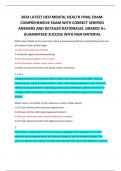Exam (elaborations)
WGU D203 FUNDAMENTALS OF ANATOMY AND PHYSIOLOGY 2024 NEW UPDATED GUIDE;ACTUAL QUESTIONS AND ANSWERS SOLVED AND VERIFIED 100%(EVERYTHING YOU NEED TO PASS D023 IS HERE)
- Course
- Institution
WGU D203 FUNDAMENTALS OF ANATOMY AND PHYSIOLOGY 2024 NEW UPDATED GUIDE;ACTUAL QUESTIONS AND ANSWERS SOLVED AND VERIFIED 100%(EVERYTHING YOU NEED TO PASS D023 IS HERE) Anatomy - The study of the body's structure Physiology - The Study of the body's functioning Levels of human body (smal...
[Show more]












